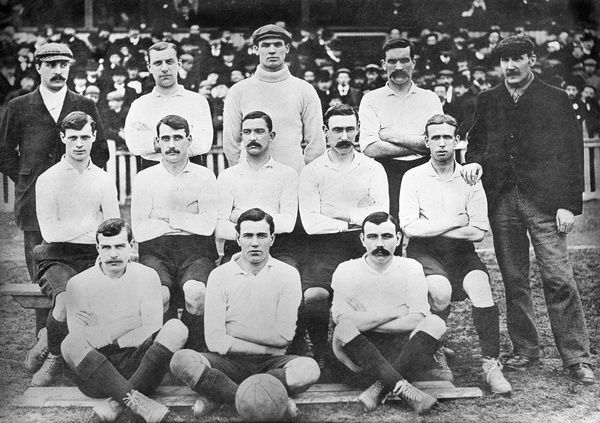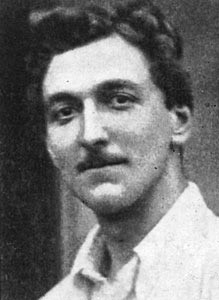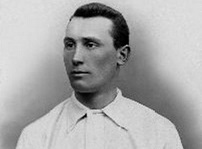CURIOUS FACTS ABOUT FULL INTERNATIONALS AND NATIONAL PLAYERS (1901)
Picture : FA Cup Final winner 1901 – Tottenham Hotspur
Interesting and curious facts about full internationals and national players (1901)
————————————————————————————————————–by IFFHS—
1901
Mark Dickson Bell, born in Edinburgh in 1881, played for Rosebery FC and St. Bernard’s FC before joining their great local rivals Heart of Midlothian (Edinburgh) in October 1900. The two-footed winger played his only full “A” international on March 2, 1901, when Scotland could only muster a 1:1 draw with Wales, the same year he won the Scottish Cup with the “Hearts”. From 1902 onwards, he changed clubs frequently: Southampton, “Hearts” again (1903/04), Fulham, back to Southampton (1906/07), and after 1910 Clapton Orient and Leyton. The Scot was of rather small stature, but quick. He also was an excellent track-and-field athlete, particularly the 100 yards dash. He later emigrated to Australia, where nothing more was heard of him.
Walter Bennett, born in Mexborough (Yorkshire) in 1874, was a miner and rather small outside right, but strong, aggressive and dangerous in front of goal. In February 1896 he joined Sheffield United. Two years later he was an English champion with them, and reached the English Cup final in 1899, 1901 and 1902, winning it on two occasions. Half-way through the 1904/05 season, “Cocky” Bennett transferred to Bristol City, and won the second division championship with them in 1906. The temperamental winger played his only full “A” international (6:0 Wales) on March 18, 1901. He joined Denaby United in 1907, the club where his career would eventually end. He still was active as a footballer when he was killed in a mining accident on April 6, 1908.
Walter Bennett
Peter Boyle, born on April 26, 1876, played professional football for Sheffield United, with whom he won the English Cup in 1899 and 1902. The defender played five full “A” internationals for Ireland between 1901 and 1904. His son Thomas Boyle also won the English Cup with Sheffield United, in 1925. When Ireland lost to Wales (0:1) in Belfast on March 23, 1901, it would be the last time for a number of years that Ireland did not field any foreign-based players, as all the good Irish players had joined the wealthy English clubs.
Charles Burgess Fry, born in Croydon on April 25, 1872, attended Repton School and then Wadham College in Oxford (until 1895). He developed into a good, athletic defender who played for Old Reptonians, Southampton FC and Portsmouth FC, from 1892 to 1903 also for Corinthians (London), as he always remained an amateur. On March 9, 1901, he played for England (3:0 Ireland), and a year later reached the English Cup final with Southampton. Along with football, and more successfully so, he played cricket for Oxford, Surrey, Sussex and Hampshire, scoring 30,886 runs all together. In track and field, he excelled at the long jump and the 100 yards dash. He held the British record for the long jump for some years, and in 1893 almost set the world record. He also played rugby for Oxford, Blackheath, Barbarians and Surrey. From 1896 to 1898 he was a schoolmaster at Charterhouse, but then decided to pursue journalism and politics. From 1898 to 1950 he was a marine trainer on the S. S. Mercury. Charles Fry died on September 7, 1956.
Charles Burgess Fry
Bertram Oswald Corbettwas born in Thame (Oxon) on May 15, 1875. He attended the Thame Grammar School and Oriel College in Oxford, where he also played football. From 1897 to 1906 he played for Corinthians (London) as well as for Reading FC. The outside left was an extremely fast dribbler. “Bertie” Corbett wrote the Annals of the Corinthians Football Club, which was published in 1906. On March 18, 1901, he played his only full “A” international. He always remained an amateur and was a teacher at Brighton College, and later a headmaster in Dorset. He died on November 30, 1967. His brother Reginald Corbett, who was four years his junior and also played on outside left, attended Malvern College and played for Old Malvernians and Corinthians, two London teams. He was a small but unpredictable winger, quite dangerous in front of goal, and played once for England on March 2, 1903 (2:1 Wales). Like his older brother, he also chose to remain an amateur and was a headmaster. He died on September 2, 1967.
James Iremongerwas born in Norton (Yorkshire) on March 5, 1876, and started playing football for Wilford and Nottingham Jardine before joining Nottingham Forest in 1896, the club he would stay with until 1910. He was a strong and two-footed defender. “Jim” Iremonger played for England once in 1901 and again in 1902. He also was a first-rate cricketer who played for Nottinghamshire from 1897 to 1914, scoring a total of 16,622 runs. From 1919 to 1927 he was a football coach with Notts County. He died on March 25, 1956.
William James Joneswas born in Penrhiwceiber near Aberdare in 1876. He played for Aberdare FC until 1901, then a few months for Kettering, from December 1901 until summer 1902 for West Ham United, and then for Aberaman and Rogerstone (1904-1906). Half-back “Bill” Jones, the first Welsh national professiona player from south Wales, played for Wales four times from 1901 to 1902. He is believed to have died during World War I in Serbia in 1918 while serving with the Royal Welsh Fusiliers.
Samuel McAlpine, born on December 7, 1878, was the goalkeeper of Cliftonville FC (Belfast). He also tended goal for Ireland when Scotland scored their all-time high win (11:0) in Glasgow on February 23, 1901. Since “Sam” McAlpine never was called up again for the Irish national team, his goal ratio of 11.00 set a sad world record. It would, however, be broken in March 1908 by Frenchman André Renaux of Racing Club de Roubaix (12.00), and some four weeks later by Norwegian Sverre Lie of Ski og FK Mercantine, Kristiania (now Oslo) (13.00).
Albert Wilkes
Albert Wilkes, born on October 1, 1874, played for Oldbury Town and Walsall before joining Aston Villa in 1898. He still was a reserve when the “Villans” were English champions in 1898/99, but the following season, when the Birmingham side successfully defended their title, he was made a regular. The right wing half played five times for England from 1901 to 1902, but his form started to decline in 1904, and his club put him back on the bench. Thus Albert Wilkes transferred to Fulham in 1906, where he played in defence. In 1909 he concluded his footballing career to devote himself to his profession as a photographer, but a fire devastated his studio. He still became a renowned photographer, especially for West Bromwich Albion, and was always developing new techniques. In September 1934 he was elected to the Aston Villa board of directors, but died on December 9, 1936.



